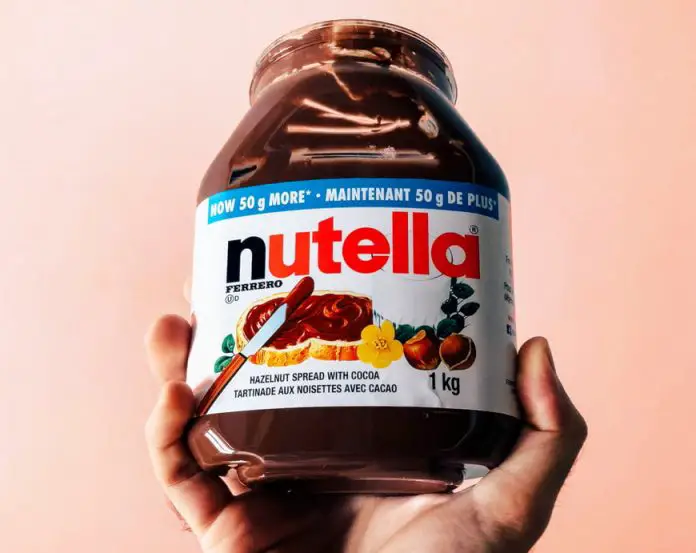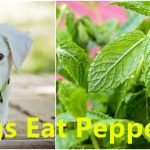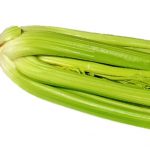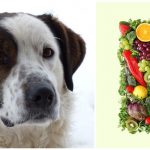
Nutella is a staple in many households and humans are not the only ones who like it. Even dogs are quite tempted to taste the heavenly goodness of this hazelnut spread.
When your dog has a penchant for sweets, he will not miss the opportunity to take a slice of bread with some Nutella spread on it. He might even beg you to have some, complete with that puppy eye look.
But should you just give in? Would an occasional lick of this spread harm your dog big-time? Let’s get some answers from the dog experts! But before we do that, it’s best to know what’s inside the jar of this globally loved chocolate spread.
Nutella 101: What’s In Your Spread?
Nutella is marketed as sweetened hazelnut cocoa spread but the primary ingredient of this spread is not really chocolate or hazelnut. Did you know that half of the entire jar of Nutella is basically sugar and palm oil? Yes, Nutella is mostly sugar and fat so don’t think of adding it to your diet if you want to lose some weight.
Aside from sugar and palm oil, Nutella also has hazelnuts, cocoa, milk, lecithin, and vanillin. Let’s take a look at whether these ingredients are safe for canines or not.
Palm oil – it is not poisonous to dogs but it has a laxative effect on them. Palm oil is present in many human foods. It is the world’s widely consumed vegetable oil. It is also added to some dog treats as filler. The palm oil added in foods is less dangerous than the palm oil that gets on the beaches, however, it could cause diarrhea and dehydration in canines. The worst thing to happen is for your pet is to develop pancreatitis. When your dog is accustomed to a low-fat diet and ingests a high-fat food, including palm oil, there is a possibility for him to develop symptoms of chronic pancreatitis. Meanwhile, those palm oil on the beaches were already mixed with other toxins such as diesel oil from ships. This is the reason why palm oil is recognized as a deadly oil for dogs.
Hazelnut – Nutella uses silken hazelnut paste, which was mildly roasted and finely ground beforehand. Thankfully, hazelnuts are not on the list of toxic nuts for dogs. Besides, you don’t have to worry that it may cause a blockage since the hazelnut is already in a paste form. Hazelnuts come with many health benefits. They are great for the skin because they contain vitamin E and reduce the risks of cancer because of their beta-sitosterol content. Furthermore, they are a rich source of folate which is necessary for cell replication and growth. Like us, our dogs also need to meet the daily requirements of folate from dietary sources. Canines need around 4 – 6 mg of folate per day.
Cocoa – it is not safe for dogs. In fact, chocolate is at the top of the list of foods that cause dog poisoning. However, you should not worry about chocolate toxicity in case your pet ate some Nutella. You have to worry more about the sugar content of Nutella, since excessive sugar can also make your dog sick. The spread only contains 7.4% of cocoa powder, not much to poison a dog. It does not have excessive amounts of methylxanthines that can kill dogs.
Milk – the milk used in Nutella is skimmed milk powder. Skim milk is already free from cream and fat but that does not make it any less of a dairy product. We all know most dogs cannot tolerate dairy, although there are some lucky ones that can easily digest it. In rare cases, canines can also be allergic to the milk’s protein content. A cup of skim milk contains around 11 grams of lactose. If your dog is lactose intolerant, he may react to the milk content in Nutella. Watch out for symptoms like vomiting and diarrhea.
Lecithin – Nutella manufacturers said they added a small amount of lecithin to increase the product’s smoothness. The lecithin used in Nutella was derived from non-genetically modified soy beans. Are soy-based products safe for canines? Dr. Joseph J. Wakshlag noted that soy is acceptable for use in dog foods, mainly due to its good protein content. Still, moderation is important. Lecithin is also being used as an ingredient in many dog supplements.
Vanillin – Nutella uses synthetic vanillin to get the same aroma of natural vanilla pods. Regular vanilla extract is not safe for dogs because of its alcohol content. Vegetable glycerin is often used in alcohol-free vanilla extracts. Imitation vanilla extracts is usually made without alcohol, so you should not worry about the vanillin content in Nutella.
Is Nutella Bad For Dogs?
Nutella is hands down delicious but it does not offer much in terms of nutritional value. Of course, we are not just basing this from a viral image of Nutella showing that the spread contains mountains of sugar. In his viral video, nutrition and weight management expert Dr. Yoni Freedhoff emphasized that Nutella is not healthy.
If it is not healthy for you, then why give it to your dog? There are other spreads, like peanut butter, that can be given to doggies without worrying they could be harmful. As long as the peanut butter is free from xylitol, it is definitely safe for your dog.
History tells us that Nutella was actually invented due to a cocoa shortage post World War II. Back in 1946, the creator of Nutella, Pietro Ferrero added hazelnuts to the spread because of the limited chocolate supply at that time.
In fact, the original recipe of Nutella contains as much as 71.5% of hazelnut paste and 19.5% of chocolate. But Nutella had to tweak their recipe over time, and it now contains only 13% hazelnut and 7.4% fat-reduced cocoa powder.
In 2017, Nutella announced a change in their recipe. The new Nutella is sweeter because it contains more skimmed milk powder. Nutella said the “fine-tuning” of their product was done to ensure a better consistency of the spread. Regardless if that modification is for good reasons or not, we cannot deny the fact that Nutella still contains lots of sugar. We already know sugar isn’t good for dogs.
Dogs and Sugar: A Deadly Combination?
Sugar is not really toxic to dogs, especially if it is naturally occurring sugar. In fact, it can provide them with energy. But as the old adage goes, everything of excess is bad. Thus, unhealthy amounts of sugar can still cause negative side effects for our pets. Sugar highs in canines involve a change in behavior. You might see that your dog looks very hyper or uncomfortable after eating foods loaded with sugar.
Based on the nutritional information posted on Nutella’s website, their product has 22 grams of total carbohydrates, lout of which 21 grams come from sugar while the remaining gram is from fiber. That amount is just for a two-tablespoon serving size. That amount of sugar can already bring your dog on a sugar high.
Chocolate Toxicity in Dogs
There was a video of a pet owner who offered his dog a small piece of bread with Nutella on top. Apparently, she received hate messages from people saying how badly treated the pooch was. On the other hand, there are those who claimed they gave their dogs chocolate occasionally and did not see any major problem. What is the truth behind the subject of chocolates and doggies?
Not all chocolates are created equal. Some chocolates have more theobromine than the others. This compound, which is the main methylxanthine component in cocoa, makes chocolate bad for dogs.
Too much chocolate in your dog’s diet could cause theobromine poisoning characterized by severe hyperactivity. This compound can do the following to our pets:
- Internal bleeding
- Heart attack
- Seizure
- Muscle tremors
Dark chocolate and baking chocolate are known to cause harm to dogs because they contain more theobromine, while milk and white chocolate have a smaller amount of it.
Aside from the type of chocolate, the size of the dog also determines how much is safe for them. In most cases, vets go against feeding puppies chocolates. Young dogs often have a more sensitive stomach than adult dogs.
An ounce or around two tablespoons of cocoa powder can cause moderate to severe toxicity to a 30-pound dog. The Toxicity Meter result even recommends seeking a veterinary attention even if the dog is not showing any symptom.
Take note that there are so many chocolate hazelnut spreads out there other than Nutella. There is a certain brand that contains other ingredients than the ones we mentioned above. Some spreads have a nutty taste, more like a peanut butter than a chocolate spread. Then there are some that are more chocolatier than the others.
My Dog Ate Nutella: What Should I Do?
If your fur baby happened to lick some, keep calm because there should not be any major problem. There is nothing to be concerned about unless he actually consumed an entire jar of Nutella. Watch out for these symptoms if you are sure your pooch has ingested quite a large quantity of the chocolate spread:
- Diarrhea
- Appetence
- Abdominal pain
- Vomiting
Consult your veterinarian or an animal poison control center if any of these symptoms are present. Don’t try to induce vomiting at home without your vet’s approval. Only your vet knows if emesis is the right thing to do given the situation. In case the vet gives you the permission to do so, administer a 3% Hydrogen Peroxide solution one time. If it did not work, repeat it only once more.
Conclusion
The issue about giving Nutella to dogs is not the chocolate in it but the contents of sugar and palm oil. A jar of Nutella is mostly fat and sugar, ingredients that could harm your dog to a certain degree. If you want to give your pet some treats, consider dog foods that are sugar-free. There are so many healthy options out there that will not harm your pet.
In a nutshell, Nutella is one of those foods you should rather not share with dog. Don’t give in to those puppy eyes and imagine how badly the hazelnut chocolate would affect your pet.






















